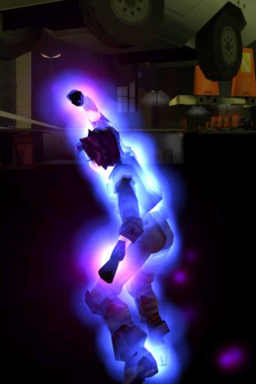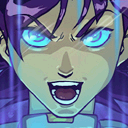Daodan
- This page is about Oni's plot concept of the Daodan Chrysalis; for the Daodan DLL patch for Windows Oni, see HERE.

| |
Chinese origin of the term Daodan | |
| 捣 | 蛋 |
| DǍO (attack, beat or disturb) |
DÀN (egg or origin) |
| T R O U B L E M A K E R N.B.: DǍO 捣 should not be confused with the better-known DÀO 道 ("way") | |
The Daodan Chrysalis is an entity which, being implanted in a human host, forms a symbiosis with it. Gradually the host's organs are replaced by improved copies grown by the Chrysalis. Developed by Professor Hasegawa in order to help humans survive the BioCrisis, the Daodan Chrysalis has been implanted in multiple characters in Oni.
Facts
Symbiotes
The word "symbiote" is not found in all dictionaries, but it is an alternate spelling of the more common "symbiont". The root of the word is Greek for "living together" and refers to the two entities together as a singular noun. The human side of the Daodan symbiote in Oni is referred to as the host.
Over the course of the story, it is revealed that the main character Konoko is a "prime symbiote"; Muro is also a prime symbiote, as revealed by this exchange with a Syndicate scientist. The Chrysalis was implanted in Konoko by Dr. Kerr while working under the TCTF and in Muro by Hasegawa and/or the Syndicate.
The existence of additional symbiotes is a matter of speculation, but there are strong hints that Mukade and Barabas are "secondary symbiotes" which are somehow inferior to the primes. See each of their sections below for elaboration.
Chrysalis
The Chrysalis is first named by Shinatama during her revealing monologue in Chapter 8: "They used me to monitor the growth of the Chrysalis inside you". It was later elaborated on by Kerr and his colleagues in Chapter 12, as seen in the leading quote in this article. The Chrysalis' growth process takes on dramatic proportions in a later description: "Konoko is closer to full transition than we ever suspected. Rough projections estimate that the Chrysalis will have infiltrated more than 80% of her body and will have replaced somewhere between 40 to 56% of her original organs."
It is mentioned one final time in-game by Mutant Muro: "I am very impressed with what you have been able to accomplish without drawing on the full power of your Chrysalis."
This optional encounter aside, the very last mention of it is in Konoko's short outro: "Mankind as we knew it is doomed: the Chrysalis will change us all. Let's hope it's for the better."
Progress
The neural link between Konoko and Shinatama allowed the TCTF to gather precise biometric data on the gradual integration of Konoko's Chrysalis with her body. Unfortunately for the TCTF, the interpretation and reporting of this information was dependent on Shinatama, who it was believed would always be truthful. It turns out at the end of the game that Shinatama had been falsifying her reports in order to protect Konoko.
Aggressiveness
Going by this console, the Daodan not only amplifies physical performance but also affects one's personality: one becomes more headstrong, and easily aggressive.
Power surges
Over the course of the game, Konoko experiences three major power surges that leave her glowing with energy. The surge takes the form of a violent spasm during which Konoko raises her arms in the air. A blue glow appears all over her body, accompanied by a soft whistling sound like a breeze. The fly-in panel of her face shows glowing eyes. The corresponding voiceover sounds ecstatic or even orgasmic (also compare to the ecstasy of Saint Teresa).
The first surge occurs after Konoko's second fight with Barabas and is not noticed by the TCTF since they are under attack at the time, but the second one is noticed by scientists at the TCTF who receive data on Konoko's vitals, and it increases the concern they have over her progressing transformation. The final surge takes place after Konoko beats Muro in CHAPTER 14 . DAWN OF THE CHRYSALIS, and this time it is powerful enough to knock back bystanders or even kill them.
Notably, the term "Daodan spike" is not used to describe this event. After the second surge, a TCTF scientist says, "Sir, I'm picking up a power surge from Processor 31-B. It's consistent with the waveforms of a Daodan spike, but far more powerful." Probably a regular Daodan spike is like an adrenal spike, but "far more powerful" already. The game resources refer to the surges using the words "powerup" and "transform". The fact that the final surge is the strongest indicates that Konoko's power is growing and she may be nearing a total transformation (the Imago stage).
It is unclear what triggers the surges exactly, but it seems to be some sort of feedback between Konoko's emotions and the Chrysalis inside her. If it was an adrenaline peak, you would expect it to happen during the fight or before it, with effects similar to the fight-or-flight response or a second wind. What makes the most sense afterwards is a sort of triumphant relief, most similar to a runner's high or an orgasm (it sounds a lot like the latter, too). It may even be a sadistic thrill from dominating her opponent.
In trying to understand the cause of the surges we might look for a simple way to describe the pattern of their occurrences, but this is not easy. One could say that Konoko experiences a dramatic surge of power after every boss fight, but this has the notable exception of the Mukade fight, and it requires us to count a room with one Fury and two Strikers as a boss fight. Another way of looking at the surges is given in this fan material.
Regardless of the exact trigger, one possibility is that the Chrysalis is using the immediate aftermath of an intense fight as an opportunity to advance significantly, responding to physical damage and taking advantage of momentary psychological weakness.
Latency
The subject of latency is repeatedly mentioned by Shinatama, Kerr and the rest of Griffin's scientific crew from Chapter 1 on. While not very informative for the player at that stage, the unfamiliar term suggests something more exotic than regular biometric data.
According to the game's dialogue, high Daodan latency is bad and low latency is good: dialogue in the first chapters suggests that a reading of 27.1 is normal and 29 is a bit alarming (also mentioned are "bioplasmic waveforms", which are expected to be "stable"). However it gets a bit more complicated than that, as consoles at TCTF Science Prison (this one and this other one) both present lowered latency as the danger, not heightened latency.
How can we reconcile this contradiction? First, "latency" apparently refers to a concept like viral latency (a dormant, inactive state), rather than the more common usage of "delay in a network connection". If this is the case then "latency" should be seen as an at-rest state. A fully latent Daodan symbiote is one where the Chrysalis lays low and doesn't manifest itself. This explains why drops in latency concern the TCTF.
A key question is what specific attribute of Konoko is being measured to determine latency. It's quite possible that the actual bio-signal being measured – intracellular energy output, the release of a brain chemical, a metabolic byproduct in her blood – represents a drop in latency when it rises, thus creating an inverse scale where higher numbers mean less latency for the Chrysalis. It could also be a combination of factors which are used to compute a single number representing "distance from full latency".
If we assume that the TCTF's scientists refer to this combined factor as "latency" for short (though certainly a word like "activity" or "potency" would have been more self-explanatory), then there is no conflict between the dialogue and consoles: higher numbers indicate greater distance from a state of latency, or in other words a drop in latency.
Hasegawa
In his diary, Professor Hasegawa alludes to the Daodan project as something that he will do to 'excuse his survival' after Jamie's death, saying, "If something isn't done we are all doomed. Jamie's death won't be in vain. I'm going to do something about the nightmare that killed her. Her brother will help me. He misses her as much as I do."
Chrysalis removal
The TCTF's researchers could not determine how to remove the Daodan tissue without killing the host. They name two reasons:
- The Daodan tissues are actually replacements for their originals, so the researcher cannot rip them out without having compatible tissue as replacements.
- The Daodan tries to repair damaged tissue almost instantly, making incision and exploratory surgery difficult.
Other ideas are:
- To communicate with the Chrysalis somehow to guide its development.
- To inject cell clusters which would attack the Daodan cells only. (It's unclear how the Daodan could react to this threat.)
Sytropin
A medicine to slow down Konoko's transformation, though with decreasing effectiveness, mentioned in this console.
Countermeasures
"Warning: target neutralization failed. Daodan symbiote organism present. Engaging Omega security mode."
Griffin is clearly concerned about how to stop a Daodan host if they go out of control or turn on the TCTF. Owing to the above difficulties in surgically removing or slowing down the Chrysalis, Griffin resorts to defensive precautions:
- The mysterious emergency override Griffin Alpha Zero, which we don't get to see.
- An office elevator leading to the super-secure Omega Vault. This may not have been constructed for the specific purpose of escaping a rogue symbiote, but instead for general security, e.g. in the case of a raid by the Syndicate. However it comes in handy when Griffin needs to escape Konoko.
- A hastily-constructed weapons platform controlled by Shinatama, once Griffin anticipates that Konoko might come for him. This includes a fallback known as Omega security mode, which we also do not get to see, as in-game it causes Shinatama to overload and break free of the Omega Vault's control.
Transformation
The concept of a physical transformation was first briefly mentioned by Griffin, and later stressed as alarming by TCTF scientists in Chapter 13: "We must hope that Konoko was destroyed when she fell into the biomatter disposal vats. [...] If not then she may be even closer to her final evolutionary stage: what form that might take, and what the presence of such a creature might portend for humanity we cannot know." After we see Mutant Muro, we can understand their concern!
Chenille glow

As mentioned under § Power surges, a Daodan host glows when their chrysalis is especially active. The effect appears blue on Konoko and red on Muro. This glow effect is referred to in the game's cheat codes as "chenille", which is French for "caterpillar". This is likely making reference to the Daodan's imago stage, implying that a transformation is closer to occurring when the glow is visible. However there is no mention in any consoles of this glow being visible to Konoko's TCTF handlers, so it is left to the player to decide if this is an extradiegetic effect.
Imago stage
The only mention of this stage by name is in the last chapter's objectives in the killed-Griffin scenario, where it is explained that "[Mutant] Muro's Daodan powers make him invulnerable, but having only just evolved he has limited energy reserves."
Wikipedia defines imago as the "last stage of development of an insect", the completion of a metamorphosis; in other words, the adult stage. The most famous instance of this transformation in the insect kingdom is the caterpillar which metamorphoses into a butterfly. There also exists a sub-imago stage in one order of insects, the short-lived mayfly.
True nature
"The Chrysalis is the hyper-evolved clone of its host body. As the host experiences stress or harm it grows to reinforce or replace the body's damaged systems."
Kerr says that the physical transformation cannot change the symbiote's personality, but rather vice versa. He claims that Konoko's final form will be an expression of the person's "true nature".
Barabas
Judging from his appearance, it's clear that Muro's top enforcer has been altered in some way. His discolored skin, not to mention the horn on his head, show that he has been mutated by something. It's likely the Chrysalis, though we don't know for sure. His bulky suit seems as much for life support as for armor. Could it be that the symbiosis has not completely "taken"? Perhaps he has a second-generation Chrysalis derived from Muro's, and thus it's not as compatible with him, or perhaps it's a new Chrysalis but is the product of an inferior process – Hasegawa seems to be absent, so perhaps the Syndicate is trying to recreate his work?
It's interesting to note that Barabas has two "superpowers": Earthquaker and his regeneration ("Stronger and stronger!"). Read on to see how this is the case with Mukade and Mutant Muro as well.
Mukade
The master ninja doesn't name the Daodan explicitly during his encounter with Mai, but his monologue seems to be alluding to the transformation process:
"Does your blood burn when you kill? Mine does. We writhe inside as we are torn apart to make way for what we will become. Surrender to it. Let the bliss of oblivion free you of all your doubts and fears..."
Mukade also has two superpowers: teleportation and the Devil Star, his homing energy attack. He can also turn invisible, but this involves pressing a button on his suit and the visual effect is the same as a phase cloak, thus it seems to be a technological ability rather than a superhuman one.
Unlike Barabas, we don't see any of Mukade's skin so we don't know if he suffers from the same discoloration, let alone whether he has any horns….
Mutant Muro
Muro in his Imago form has access to almost unlimited energy which he can use to attack and shield himself from harm. This explains why the TCTF fears Konoko's transformation so much. Muro's shield would make him invulnerable if it weren't for the fact that he is newly transformed and sometimes loses the shield when expending energy on attacks.
Mutant Muro has two superpowers: his attractive lightning which picks up a target and brings it to him, and his defensive attack which emits 360° of repelling lightning.
Added value
The Daodan concept is easily the most original and powerful in all of Oni. It neatly maps onto society, technology, personality etc., and it can also be considered on its own, as an appealing sci-fi concept and the embodiment of not-so-trivial dilemmas (ethical and otherwise).
Autoevolutionary process
The Daodan is designed to run free: to come up with an adapted response to complex or unforeseeable challenges, to "react as it sees fit". There are virtually no limits imposed on that hyper-evolution by the designer. Rather than making the "patched" humans able to withstand specific toxins found in the BioCrisis, the idea is to provide a dynamic cure for any toxin there could ever be. Which sounds very nice, but brings about a few disturbing aspects….
Mender and catalyst
The Daodan can heal and reinforce existing bodily structures or replace them with radically new ones. This dual selection process is mainly triggered by externally applied stress or harm. The overall long-term effect somehow remains aligned with the quintessence of the host, its "true nature" as Kerr puts it.
Practically, though, the "patch" is gradually extending throughout the host, redefining the "nature" of the host organism as it does so. It's a biological corollary to Ghost in the Shell's depiction of massive cyborgization of a human body: enhancing it with synthetic patches until the body is one big patch surrounding a vanishingly small human core (a ghost inside a shell).
Smart cancer
Nanotechnological medicine, a concept found in cyberpunk, features smart hyper-miniaturized robots that can fight diseases at the cellular level. Those robots, however, are specialized for a particular use as they are the product of human designers and engineers.
The Daodan is different in that it is 100% biological; it's even different from grafts and implants of tissue from a human donor, because the Daodan-enhanced tissue is originally that of the host himself. That, and the fact that the tissue ends up significantly changed, suggests that the Daodan can be labeled as an extreme form of cancer. Basically, the Chrysalises implanted in Muro and Mai were comparable to tumors (aggregates of cancer cells), and the different growth processes occurring inside them are equivalent to metastasis.
Cancer disrupts the normal equilibrium of cell division and cell death and thus affects the organism's integrity. The Daodan does pretty much the same thing (note the connection of the aforementioned equilibrium to the "stability" of a host/Daodan "symbiote"). However, the Daodan's mutation isn't random, thus the process is considerably different from a proliferation of tumors and does not result in death the way regular cancer does.
The Daodan is smart about its progression through the organism. Its core "hyper-evolutionary" design is an auto-adaptive upgrade of the host, which results in assimilating, reinforcing and enhancing existing structures, rather than haphazardly filling any vital space it can get. A sort of dynamic integrity is thus maintained, leading to increased resilience and preservation of the host rather than its death.
The Daodan serves its host as best it can. Which is more or less the altruistic goal claimed by Hasegawa. So, is everything fine? Not really...
Efficiency and loss of control
The key idea of the Daodan design is that in order to achieve outstanding performance (efficiency, power), you have to give up control. That's what Kerr and his colleagues keep talking about, and that's what Muro and Mai illustrate, each in their own way: Muro escaped the Syndicate's control in pretty much the same way as Mai escaped Griffin's.
Point is: with the Daodan, one should always expect the unexpected. The fact that the theory itself denies any kind of accurate control and prediction is what makes the Daodan so different from any other prototype technology. Whatever widget comes up in sci-fi, even if it never served before, one always knows what it's supposed to do. With the Daodan, one doesn't have such luxury.
And so the very notion of Daodan expertise doesn't really apply: Kerr is the closest thing to a subject matter expert that we see, and all he can do is observe its development and make vague predictions.
What comes closest to expertise is the awareness of the theory's self-imposed limitations. What comes closest to incompetence is the overlooking thereof. Rather than the overlooking of a particular element of a hypothetical control/confinement scheme, it's the illusion that control/confinement schemes are at all viable which is irresponsible.
Confidence in the upgrading process is also a delusion akin to wishful thinking. Thus it is a suitable invention for an idealist-altruist such as Hasegawa or Kerr. Assuming that the Daodan can do no wrong is just as irresponsible as claiming full control of the consequences, be they good or bad.
As for Muro, he's aware of the problem, but doesn't care much about control. STURMANDERUNG is supposed to bring about eternal life and anarchy for the survivors, and it's not clear that Muro cares who survives exactly. As a "stable" symbiote who's already safe, any outcome seems fine to him.
Alienation and loss of humanity
The "power vs. alienation" dilemma is best illustrated by the Barabas experiment.
Alienation as such is best explored through the characters of Mai and Muro.
Hyper-evolution of Man
Effectively, there's a hell of a gap between a thoroughly upgraded (hyper-evolved) human being and a regular human, both physiologically and psychologically. Actually, there's no well-defined limit or goal to the Daodan process.
So much of a difference that the Imago can be regarded as another race, another species… which is close to the basic concept of extra-terrestrial intelligence, no matter if the Daodan's origin is entirely human or not.
Inner struggle
At any given moment, the upgraded (hyper-evolved and hyper-evolving) biomass and the still-completely-human cells are distinguishable. There's the human host and its hyper-evolved clone, the Chrysalis.
There is no merging between the "tumors" and the intact organs. As the process progresses, the human host loses its original genetic signature as organs are claimed by the Daodan biomass. There's an invader, an invaded, and a front line between the two, rather than a transformation occurring uniformly over the whole organism.
Given enough time, the process extends to all of the host's systems (because by design there seems to be no limit to the scope of the "patch"). That means the nervous system and the brain will be subject to an upgrade, too. At that point we have a Ship of Theseus situation in the body of a human.
The biological struggle at cellular level (the host's immune response to that strange invader: an upgraded copy of itself) is a bit tedious. But once the smart cancer begins to upgrade the host's brain (who said it doesn't need upgrading? sure does!), the picture gets much more juicy.
Basically it's the old Doppelgänger nightmare – what happens if your clone or double kills you and usurps your identity? – except the killing and usurpation happens inside one single body.
Love
Transitioning to the Imago stage could be compared to falling in love. Passion confers an element of mania which dulls practical considerations such as common sense. In a way, "true lovers" don't belong to this world: they're beyond the community, beyond reason, etc.
Goal
The process has no declared goal other than a relentless mending of defects and alchemizing of resources: a constant evolution towards "something" (perfection?).
One can then wonder what the finality is, if any. Is it the Imago stage, whatever it is? Can one avoid transitioning to the Imago stage? If so, could that be the goal: balancing on the edge between human and Imago?
Repeated Imago
The Imago concept, upon reflection, brings up some unusual questions. If the purest Imago state is achieved, then the Chrysalis has nothing more to adapt to or build upon. Does it simply cease to exist, having totally integrated with its host? Could the unified Imago symbiote possibly be implanted with another Chrysalis? If so, then one must wonder at the monsters that may occur….
Meaning
People with different backgrounds and attitudes will likely fail to consider the Daodan concept from a philosophical or scientific point of view, and will attribute a very practical value to the entity and process, depending on what the Daodan means to them in the context. A Daodan can thus be regarded as a tool, a weapon, a cure, an antidote, a threat, insurance, sacrilege….



